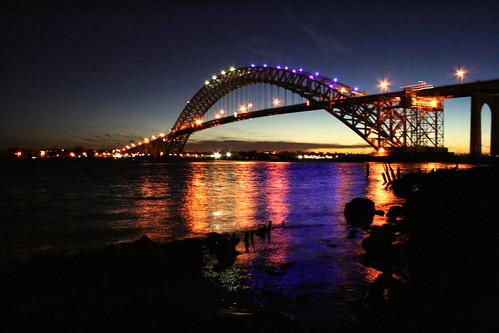The Bayonne Bridge is the fourth longest steel arch bridge in the world, and was the longest in the world at the time of its completion.[3][4] It connects Bayonne, New Jersey with Staten Island, New York, spanning the Kill Van Kull. Despite popular belief, it is not a national landmark.
The bridge was designed by master bridge-builder Othmar Ammann and the architect Cass Gilbert. It was built by the Port of New York Authority and opened on November 15, 1931, after dedication ceremonies were held the previous day.[5]
The Port Authority is planning to rebuild the roadway higher within the existing arch to allow larger container ships to pass underneath.[6]
Ammann, the master bridge builder and chief architect of the Port Authority, chose the steel arch design after rejecting a cantilever and suspension design as expensive and impractical for the site, given a requirement by the Port Authority that the bridge must be able to accommodate the future addition of rapid transit tracks.[7]
The eventual design of the bridge called for a graceful arch that soars 266 feet (69 m) above the Kill Van Kull[8] and supports a road bed for 1,675 feet (511 m) without intermediary piers. The total length of the bridge is 8,640 feet (2,633 m) with a mid-span clearance above the water of 150 feet (46 m). The arch resembles a parabola, but is made up of 40 linear segments.
The design of the steel arch is based on the Hell Gate Bridge designed by Ammann's mentor, Gustav Lindenthal.[9] Gilbert had designed an ornamental granite sheathing over the steelwork as part of the original proposal, but as in the case of the George Washington Bridge, the stone sheathing was eliminated in order to lower the cost of the bridge, leaving the steel trusses exposed. It was the first bridge to employ the use of manganese steel for the main arch ribs and rivets.[10]
Construction on the bridge began in 1928, and eventually cost $13 million. When it opened on November 15, 1931, it was the longest steel arch bridge in the world.[11] Although it was deliberately built a few feet longer than the Sydney Harbour Bridge, David M. Dow, the Secretary for Australia in the United States, attended the dedication ceremony and noted that the bridge in Sydney was much larger and contained more than double the amount of steel. The same pair of golden shears used to cut the ribbon for the Bayonne Bridge was sent to Australia for the ribbon cutting of the Sydney Harbour Bridge.[5][12]
The presence of the Bayonne Bridge ultimately led to the discontinuation of the Bergen Point Ferry.
The supported roadway carries two lanes of traffic in each direction. The roadway deck could accommodate an expansion for either two traffic lanes or two light-rail lanes. A pedestrian walkway, cantilevered from the western side of the roadway, currently provides the only access by foot to Staten Island; at more or less normal walking speed, it takes approximately 25–30 minutes to walk from the street access on one side of the bridge to the street access on the other side. The Port Authority also permits bicycle traffic, however the sidewalk ends abruptly at descending stairs on the New Jersey side. Due to safety concerns, bicycle riders are required to walk their bicycles across the bridge.[13]
Tolls are collected on vehicles traveling into Staten Island (there is no toll for vehicles traveling into New Jersey).
As of September 18, 2011, the cash tolls going from New Jersey to Staten Island will be charged $12 for cars and $11 for motorcycles (there is no toll for passenger vehicles going from Staten Island to New Jersey). All E-ZPass users will be charged $7.50 for cars and $6.50 for motorcycles during off-peak hours (outside of 6-10 am and 4-8 pm on the weekdays; and outside of 11 am - 9 pm on the weekends) and $9.50 for cars and $8.50 for motorcycles during peak hours (6-10 am and 4-8 pm on the weekdays; and 11 am - 9 pm on the weekends).[1]
In September 2007, the New York City Transit Authority began a limited-stop bus route (the S89 ) that crosses the bridge. The route's termini are the Hylan Boulevard bus terminal in Eltingville, Staten Island and the 34th Street Hudson-Bergen Light Rail Station in Bayonne. This is the first interstate bus service offered by the MTA.[14]
In 2003, the bridge carried about 20,000 vehicles per day.
The Bayonne Bridge was designated as a National Historic Civil Engineering Landmark by the American Society of Civil Engineers in 1985.[10] Source: Wikipedia.
20120103
Bayonne Bridge...at its best
Subscribe to:
Post Comments (Atom)


No comments:
Post a Comment